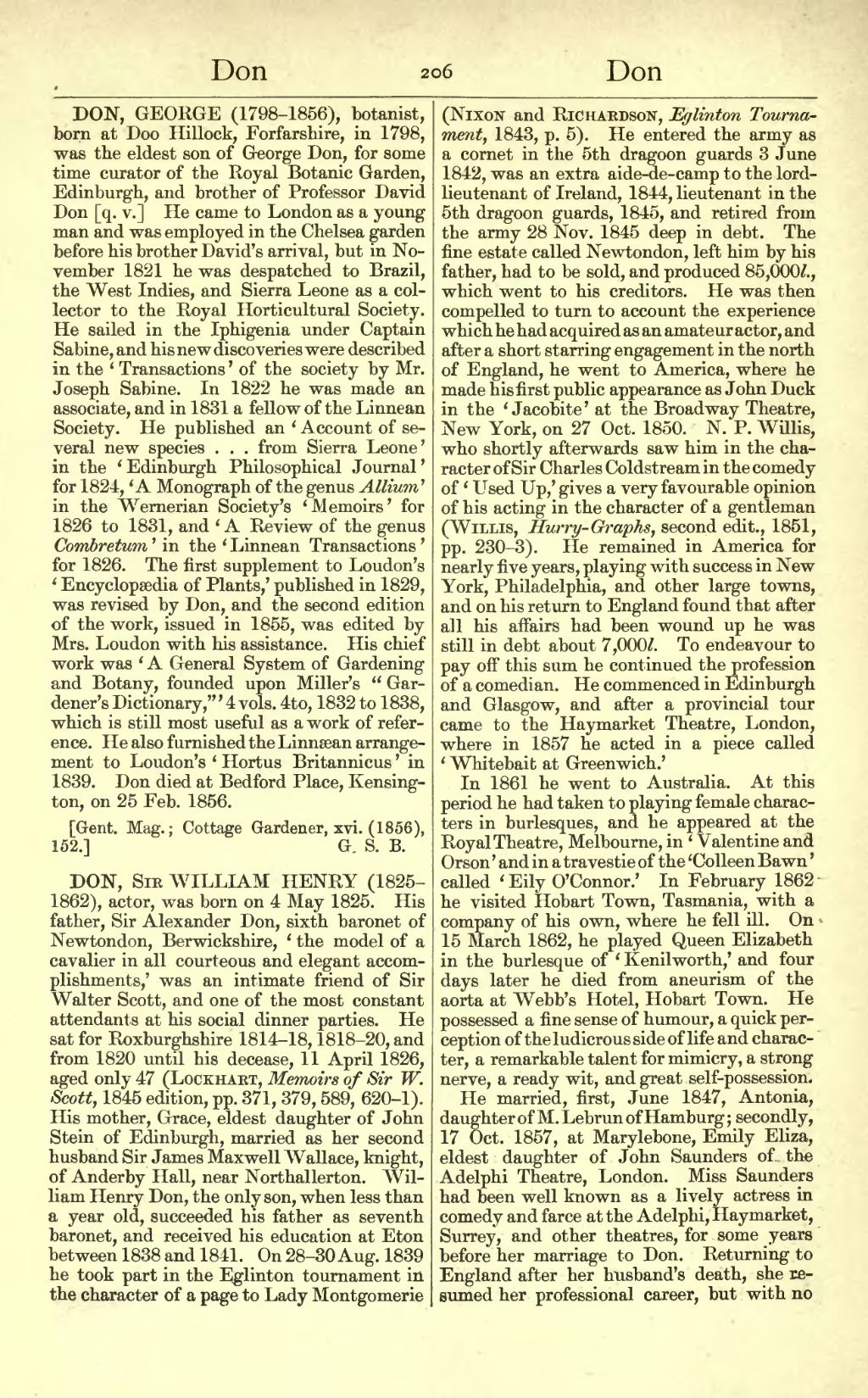DON, GEORGE (1798–1856), botanist, born at Doo Hillock, Forfarshire, in 1798, was the eldest son of George Don, for some time curator of the Royal Botanic Garden, Edinburgh, and brother of Professor David Don [q. v.] He came to London as a young man and was employed in the Chelsea garden before his brother David's arrival, but in November 1821 he was despatched to Brazil, the West Indies, and Sierra Leone as a collector to the Royal Horticultural Society. He sailed in the Iphigenia under Captain Sabine, and his new discoveries were described in the ‘Transactions’ of the society by Mr. Joseph Sabine. In 1822 he was made an associate, and in 1831 a fellow of the Linnean Society. He published an ‘Account of several new species … from Sierra Leone’ in the ‘Edinburgh Philosophical Journal’ for 1824, ‘A Monograph of the genus Allium’ in the Wernerian Society's ‘Memoirs’ for 1826 to 1831, and ‘A Review of the genus Combretum’ in the ‘Linnean Transactions’ for 1826. The first supplement to Loudon's ‘Encyclopædia of Plants,’ published in 1829, was revised by Don, and the second edition of the work, issued in 1855, was edited by Mrs. Loudon with his assistance. His chief work was ‘A General System of Gardening and Botany, founded upon Miller's “Gardener's Dictionary,”’ 4 vols. 4to, 1832 to 1838, which is still most useful as a work of reference. He also furnished the Linnæan arrangement to Loudon's ‘Hortus Britannicus’ in 1839. Don died at Bedford Place, Kensington, on 25 Feb. 1856.
[Gent. Mag.; Cottage Gardener, xvi. (1856), 152.]
DON, Sir WILLIAM HENRY (1825–1862), actor, was born on 4 May 1825. His father, Sir Alexander Don, sixth baronet of Newtondon, Berwickshire, ‘the model of a cavalier in all courteous and elegant accomplishments,’ was an intimate friend of Sir Walter Scott, and one of the most constant attendants at his social dinner parties. He sat for Roxburghshire 1814–18, 1818–20, and from 1820 until his decease, 11 April 1826, aged only 47 (Lockhart, Memoirs of Sir W. Scott, 1845 edition, pp. 371, 379, 589, 620–1). His mother, Grace, eldest daughter of John Stein of Edinburgh, married as her second husband Sir James Maxwell Wallace, knight, of Ainderby Hall, near Northallerton. William Henry Don, the only son, when less than a year old, succeeded his father as seventh baronet, and received his education at Eton between 1838 and 1841. On 28–30 Aug. 1839 he took part in the Eglinton tournament in the character of a page to Lady Montgomerie (Nixon and Richardson, Eglinton Tournament, 1843, p. 5). He entered the army as a cornet in the 5th dragoon guards 3 June 1842, was an extra aide-de-camp to the lord-lieutenant of Ireland, 1844, lieutenant in the 5th dragoon guards, 1845, and retired from the army 28 Nov. 1845 deep in debt. The fine estate called Newtondon, left him by his father, had to be sold, and produced 85,000l., which went to his creditors. He was then compelled to turn to account the experience which he had acquired as an amateur actor, and after a short starring engagement in the north of England, he went to America, where he made his first public appearance as John Duck in the ‘Jacobite’ at the Broadway Theatre, New York, on 27 Oct. 1850. N. P. Willis, who shortly afterwards saw him in the character of Sir Charles Coldstream in the comedy of ‘Used Up,’ gives a very favourable opinion of his acting in the character of a gentleman (Willis, Hurry-Graphs, second edit., 1851, pp. 230–3). He remained in America for nearly five years, playing with success in New York, Philadelphia, and other large towns, and on his return to England found that after all his affairs had been wound up he was still in debt about 7,000l. To endeavour to pay off this sum he continued the profession of a comedian. He commenced in Edinburgh and Glasgow, and after a provincial tour came to the Haymarket Theatre, London, where in 1857 he acted in a piece called ‘Whitebait at Greenwich.’
In 1861 he went to Australia. At this period he had taken to playing female characters in burlesques, and he appeared at the Royal Theatre, Melbourne, in ‘Valentine and Orson’ and in a travestie of the ‘Colleen Bawn’ called ‘Eily O'Connor.’ In February 1862 he visited Hobart Town, Tasmania, with a company of his own, where he fell ill. On 15 March 1862, he played Queen Elizabeth in the burlesque of ‘Kenilworth,’ and four days later he died from aneurism of the aorta at Webb's Hotel, Hobart Town. He possessed a fine sense of humour, a quick perception of the ludicrous side of life and character, a remarkable talent for mimicry, a strong nerve, a ready wit, and great self-possession.
He married, first, June 1847, Antonia, daughter of M. Lebrun of Hamburg; secondly, 17 Oct. 1857, at Marylebone, Emily Eliza, eldest daughter of John Saunders of the Adelphi Theatre, London. Miss Saunders had been well known as a lively actress in comedy and farce at the Adelphi, Haymarket, Surrey, and other theatres, for some years before her marriage to Don. Returning to England after her husband's death, she resumed her professional career, but with no
